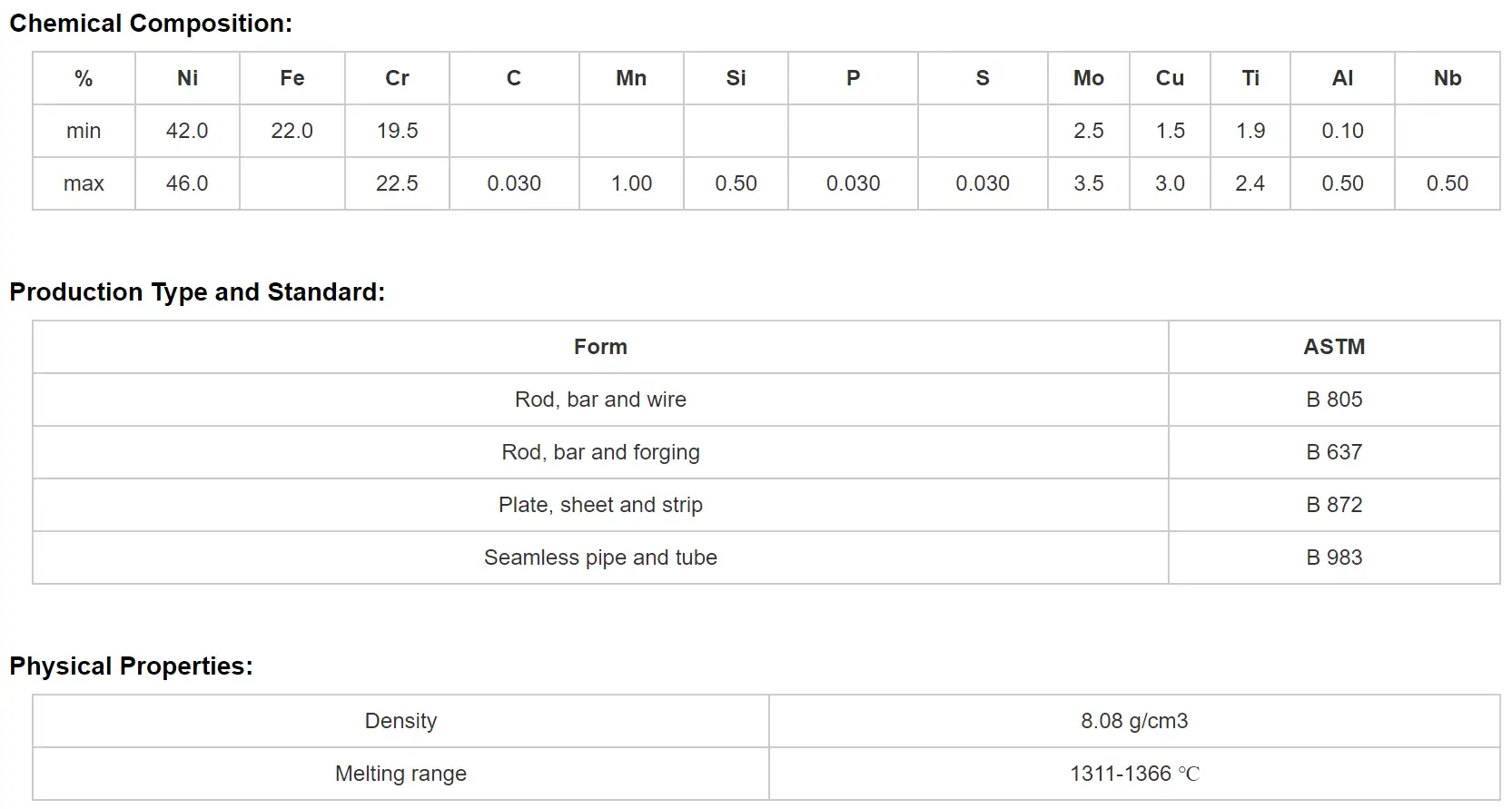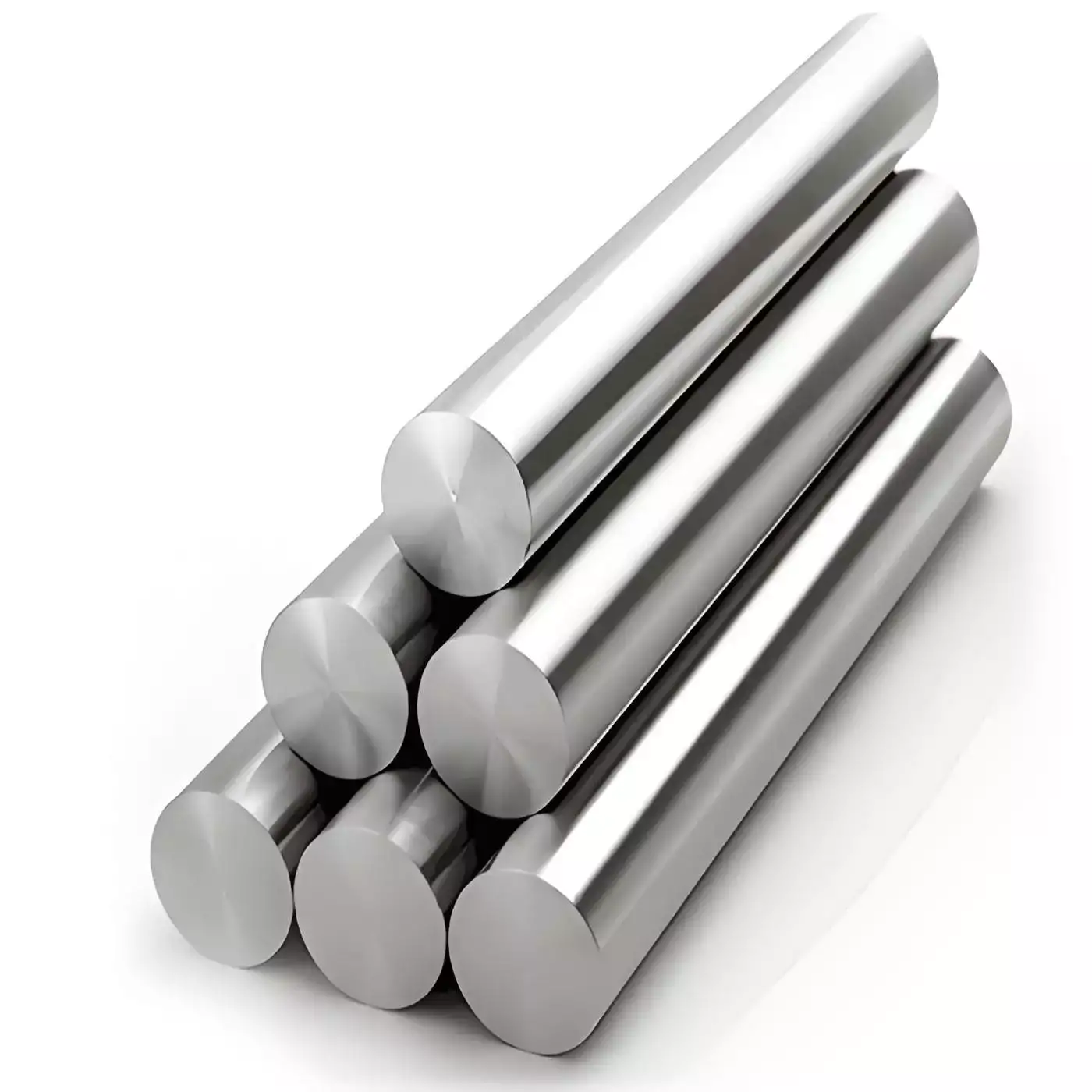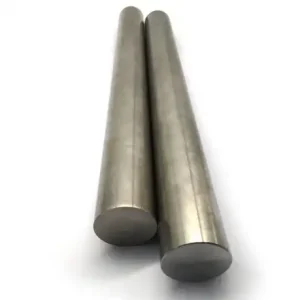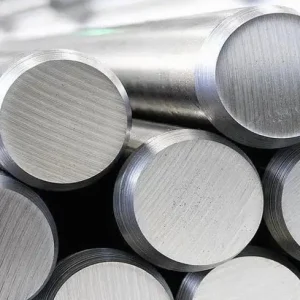Legierung 925, auch bezeichnet als Nickel-Legierung 925besteht in erster Linie aus Nickel (45-55%), Chrom (18-23%) und Molybdän (3-4%), mit zusätzlichen Elementen wie Kupfer, Titan und Eisen. Diese Zusammensetzung verleiht der Legierung eine bemerkenswerte Beständigkeit gegen Oxidation, Korrosion und Spannungsrisskorrosion, insbesondere in marinen und chemischen Umgebungen. Legierung 925 wurde für Anwendungen entwickelt, bei denen sowohl eine hohe mechanische Festigkeit als auch eine ausgezeichnete Korrosionsbeständigkeit erforderlich sind, wie z. B. in der Luft- und Raumfahrt, der Offshore-Öl- und Gasindustrie und der chemischen Verarbeitung.
1. Wichtige Eigenschaften der Legierung 925
Physikalische Eigenschaften
Die folgende Tabelle gibt einen Überblick über die wichtigsten physikalischen Eigenschaften von Legierung 925:
| Eigentum | Wert | Details/Bemerkungen |
|---|---|---|
| Dichte | 8,94 g/cm³ | Die Dichte ist hoch, was typisch für Nickelbasislegierungen ist. |
| Schmelzpunkt | 1350°C (2462°F) | Der hohe Schmelzpunkt gewährleistet eine hohe Leistungsfähigkeit bei hohen Temperaturen. |
| Wärmeleitfähigkeit | 10,3 W/m-K bei 100°C | Die niedrige Wärmeleitfähigkeit unterstützt die Leistung bei hohen Temperaturen. |
| Wärmeausdehnungskoeffizient | 13,1 µm/m-K (20-100°C) | Niedriger Koeffizient, nützlich zur Verringerung von Spannungen bei thermischen Zyklen. |
Mechanische Eigenschaften
Die Legierung 925 weist hervorragende mechanische Eigenschaften auf, die für ihre Leistung in hochbelasteten Umgebungen unerlässlich sind:
| Eigentum | Wert | Details/Bemerkungen |
|---|---|---|
| Zugfestigkeit | 1030 MPa (150 ksi) | Gibt die Fähigkeit der Legierung an, einer Spannung standzuhalten, bevor sie bricht. |
| Streckgrenze | 690 MPa (100 ksi) | Zeigt den Widerstand des Materials gegen plastische Verformung unter Last. |
| Dehnung | 45% (in 50 mm Messlänge) | Eine hohe Dehnung ist ein Hinweis auf die Dehnbarkeit des Materials. |
| Härte | Rockwell B85 | Misst den Widerstand der Legierung gegen Eindrücken. |
Korrosionsbeständigkeit
Die Legierung 925 ist sehr widerstandsfähig gegen eine Vielzahl von korrosiven Umgebungen, einschließlich:
-
Lochfraß und Spaltkorrosion: Hervorragende Beständigkeit gegen örtliche Korrosion, daher für den Einsatz im Meer geeignet.
-
Oxidationsbeständigkeit: Die Legierung funktioniert gut in oxidierenden Umgebungen und behält ihre Integrität auch bei hohen Temperaturen.
-
Spannungsrisskorrosion: Die Legierung 925 ist resistent gegen Spannungsrisskorrosion, insbesondere in chloridhaltigen Umgebungen wie Meerwasser.
Leistung bei hohen Temperaturen
Die Legierung 925 behält ihre mechanischen Eigenschaften auch bei hohen Temperaturen bei und ist oxidationsbeständig bis zu 1800°F (982°C). Dadurch eignet es sich für Hochleistungsanwendungen wie Turbinen und Abgassysteme.

2. Zusammensetzung der Legierung 925
Die Zusammensetzung der Legierung ist so ausgewogen, dass sie sowohl in Bezug auf die mechanischen Eigenschaften als auch auf die Korrosionsbeständigkeit optimale Ergebnisse liefert:
| Element | Prozentsatz (%) |
|---|---|
| Nickel | 45-55% |
| Chrom | 18-23% |
| Molybdän | 3-4% |
| Kupfer | 1.5-3% |
| Titan | 0.5-1.5% |
| Eisen | ≤1% |
| Element | Zusammensetzung (wt%) |
|---|---|
| Cr | 19.5 - 22.5 |
| Cu | 1.5 - 3.0 |
| Fe | 22,0 (Saldo) |
| Mo | 2.5 - 3.5 |
| Ni | 42.0 - 46.0 |
| Ti | 1.9 - 2.4 |
Zusätzliche Hinweise:
-
Ni (Nickel) ist das Basiselement, das Korrosionsbeständigkeit und Hochtemperaturstabilität gewährleistet.
-
Fe (Eisen) ist in beträchtlichen Mengen vorhanden (~22%), wodurch die Legierung 925 als ein Nickel-Eisen-Chrom-Legierung.
-
Ti (Titan) ermöglicht Ausscheidungshärtung in Kombination mit Al (der Al-Gehalt ist jedoch minimal und nicht immer angegeben).
3. Anwendungen der Legierung 925
Luft- und Raumfahrtindustrie
Die Legierung 925 wird verwendet für Luft- und Raumfahrt für Komponenten wie Gasturbinen, Abgassysteme und Motorenteile, bei denen sowohl Hochtemperaturfestigkeit als auch Oxidationsbeständigkeit entscheidend sind.
Chemische Verarbeitung
In der chemischen Verarbeitungsindustrie ist die Legierung 925 ideal für Komponenten wie Wärmetauscher, Reaktorbehälter und Rohrleitungssysteme, da sie gegen Korrosion durch Chemikalien wie Schwefelsäure, Salzsäure und Meerwasser beständig ist.
Offshore-Öl und Gas
Die Legierung 925 ist ein bevorzugtes Material für die Offshore-Öl und -Gas für Bauteile, die Meeresumgebungen und hohen mechanischen Beanspruchungen ausgesetzt sind. Die Beständigkeit der Legierung gegen Lochfraß und Spaltkorrosion macht sie zu einer ausgezeichneten Wahl für Unterwasserausrüstungen und Pipelines.
Schiffsindustrie
Aufgrund seiner Beständigkeit gegen Seewasserkorrosion wird die Legierung 925 häufig in Marine Anwendungen wie Schiffsrümpfe, Propeller und Unterwassermaschinen.
4. Warum die Legierung 925?
Auswahl von Legierung 925 für anspruchsvolle industrielle Anwendungen bietet mehrere Vorteile:
-
Korrosionsbeständigkeit: Ideal für Industrien, die Meerwasser oder chemischen Umgebungen ausgesetzt sind.
-
Hohe Festigkeit und Langlebigkeit: Hervorragende mechanische Festigkeit, die eine lange Lebensdauer in stark beanspruchten Anwendungen gewährleistet.
-
Hitzebeständigkeit: Gute Leistung in Umgebungen mit hohen Temperaturen, bis zu 1800°F (982°C).
-
Widerstandsfähigkeit gegen Spannungsrisskorrosion: Ideal für Anwendungen in chloridreichen Umgebungen, wie z. B. in der Schifffahrt und bei Offshore-Bohrungen.
5. Herstellung und Umformung von Alloy 925
Legierung 925 kann mit einer Vielzahl von Fertigungsverfahren hergestellt werden, darunter Gießen, Schmieden und Schweißen. Bei MWalloys liefern wir Alloy 925 in den folgenden Formen:
-
Platte: Wird häufig für Strukturbauteile und Wärmetauscher verwendet.
-
Bar: Wird für Wellen, Ventile und andere mechanische Komponenten verwendet.
-
Rohrleitung: Wird in stark beanspruchten Rohrleitungssystemen eingesetzt, z. B. in Chemieanlagen und auf Bohrinseln.
-
Rohr: Einsatz in Hochleistungswärmetauschern und anderen kritischen Anwendungen.
Schweisslegierung 925 erfordert spezielle Verfahren, damit die hohe Korrosionsbeständigkeit des Materials erhalten bleibt. Zu den gängigen Schweißverfahren gehören WIG und MIG Schweißen unter Verwendung kompatibler Schweißzusätze, die die mechanischen und chemischen Eigenschaften der Legierung erhalten.
6. Vergleich mit ähnlichen Legierungen
| Eigentum | Legierung 925 | Inconel 718 | Monel 400 |
|---|---|---|---|
| Korrosionsbeständigkeit | Ausgezeichnet | Gut | Sehr gut |
| Hochtemperaturbeständigkeit | Bis zu 1800°F (982°C) | Bis zu 1300°F (704°C) | Bis zu 1400°F (760°C) |
| Stärke | Hoch | Sehr hoch | Mäßig |
| Anwendungen | Luft- und Raumfahrt, Chemie, Marine | Luft- und Raumfahrt, Öl und Gas | Marine, Chemie |
Wie aus der Vergleichstabelle hervorgeht, bietet die Legierung 925 eine bessere Korrosionsbeständigkeit und Hochtemperaturleistung im Vergleich zu Monel 400obwohl es nicht die gleiche Hochtemperaturfähigkeit besitzt wie Inconel 718.
7. Legierung 925 beim Schweißen
Schweißen Legierung 925 erfordert besondere Aufmerksamkeit, um Oxidation oder Rissbildung zu vermeiden. Die Legierung kann mit den folgenden Verfahren geschweißt werden:
-
Gas-Wolfram-Lichtbogenschweißen (GTAW): Bevorzugt für Präzisionsschweißungen.
-
Gas-Metall-Lichtbogenschweißen (GMAW): Geeignet für dickere Profile.
-
Metall-Schutzgasschweißen (SMAW): Häufig für schwere Anwendungen verwendet.
Einfüllstangen kompatibel mit Legierung 925 sind erhältlich, um starke, korrosionsbeständige Schweißnähte zu gewährleisten.
8. Pflege und Langlebigkeit der Legierung 925
Bei der Auswahl eines Materials wie der Legierung 925 für industrielle Anwendungen ist es entscheidend, wie gut es im Laufe der Zeit funktionieren wird. Dazu gehören sowohl die physische Beständigkeit als auch die Widerstandsfähigkeit gegen Verschleiß und Degradation. Bei MWalloys legen wir großen Wert darauf, unseren Kunden langlebige Materialien zu liefern, und Alloy 925 ist da keine Ausnahme. Alloy 925 ist für seine Robustheit bekannt und kann den härtesten Umgebungen widerstehen, was einen minimalen Wartungsaufwand und langfristige Zuverlässigkeit gewährleistet.
Wie lange ist die Legierung 925 haltbar?
Legierung 925 hat eine außergewöhnliche Lebensdauer, wenn es in geeigneten Anwendungen eingesetzt wird. Die Korrosions- und Oxidationsbeständigkeit der Legierung sorgt dafür, dass sie selbst in rauen chemischen und maritimen Umgebungen nicht schnell abbaut. In Anwendungen wie Offshore-Bohrung, chemische Verarbeitungund Luft- und RaumfahrtBauteile aus der Legierung 925 können bei richtiger Pflege jahrzehntelang ohne nennenswerte Beeinträchtigung halten.
Leistung im Laufe der Zeit
Im Laufe der Zeit behält die Legierung 925 ihre Festigkeit, Korrosionsbeständigkeit und Hochtemperaturleistung bei. Da sie gegen Korrosion durch Meerwasser, Säuren und viele Industriechemikalien beständig ist, bleibt sie eine ideale Wahl für Industrien mit aggressiven Arbeitsbedingungen. Regelmäßige Inspektion und Wartung, insbesondere in hochdynamischen Umgebungen wie Offshore-Ölplattformen oder chemische Reaktorenkann die Langlebigkeit verlängern und eine optimale Leistung während der gesamten Lebensdauer gewährleisten.
Ermüdungswiderstand
Eine der herausragenden Eigenschaften der Legierung 925 ist ihre Ermüdungsbeständigkeit. Diese Eigenschaft macht die Legierung besonders nützlich für Anwendungen, die wiederkehrende Belastungen beinhalten, wie z. B. Komponenten in Turbinen oder Druckbehältern. Selbst bei zyklischen Belastungen behält Alloy 925 seine strukturelle Integrität und zeigt keine Risse oder Verschleißerscheinungen, was ihn zur ersten Wahl für kritische Teile in hochbelasteten Umgebungen macht.
Langfristige Leistung
Mit der richtigen Pflege und regelmäßigen Inspektionen, Legierung 925 Komponenten können jahrzehntelang zuverlässig arbeiten. Die Kombination aus hohe mechanische Festigkeit, Beständigkeit gegen Spannungsrisskorrosionund Hochtemperaturtoleranz gewährleistet, dass Legierung 925 kann während seines gesamten Lebenszyklus effizient arbeiten und den Bedarf an Reparaturen oder Ersatz minimieren.
9. Globale Versorgung und Verfügbarkeit der Legierung 925
Die Legierung 925 wird dank ihrer Vielseitigkeit und ihrer außergewöhnlichen Leistungsmerkmale auf der ganzen Welt verwendet. Wir bei MWalloys sind stolz auf unsere starke, globale Lieferkette, die sicherstellt, dass die Legierung 925 für Kunden aus allen Branchen leicht verfügbar ist.
Woher kommt die Legierung 925?
Die Legierung 925 wird in mehreren wichtigen Regionen hergestellt, darunter Nordamerika, Europa und Teile Asiens. Führende Hersteller, z. B. in den Vereinigten Staaten, Deutschland und China, liefern hochwertige Legierung 925 in verschiedenen Formen und Größen. Die Legierung ist in der Regel nach internationalen Normen zertifiziert, um sicherzustellen, dass die Kunden ein hochwertiges Produkt erhalten, das ihren spezifischen Anforderungen entspricht.
Regionale Verfügbarkeit
Während Alloy 925 in den wichtigsten Industrieregionen wie den Vereinigten Staaten, Europa und Asien leicht erhältlich ist, kann es in abgelegenen Gebieten zu längeren Lieferzeiten oder Problemen mit der Verfügbarkeit kommen. Für Kunden in Regionen mit begrenztem Zugang zu Alloy 925 bietet MWalloys einen schnellen globalen Versand, um eine rechtzeitige Lieferung zu gewährleisten. Unser weltweites Vertriebsnetz garantiert, dass sich Kunden in allen Teilen der Welt auf uns verlassen können, wenn es um hochwertige Legierung 925 geht.
Verfügbarkeit auf Lager
MWalloys unterhält einen großen Bestand an Alloy 925, um sicherzustellen, dass wir Kundenaufträge schnell erfüllen können. Von großen industriellen Komponenten bis hin zu kleineren Teilen und Armaturen haben wir eine große Auswahl an Alloy 925 Produkten auf Lager, um die Bedürfnisse unserer Kunden zu erfüllen. Unser großer Lagerbestand ermöglicht uns kurze Lieferzeiten, so dass Sie Ihre Alloy 925 Materialien ohne Verzögerung erhalten können.
Überlegungen zur Lieferkette
Obwohl Alloy 925 von einem Netzwerk vertrauenswürdiger Hersteller produziert und geliefert wird, kann die Verfügbarkeit des Materials durch Probleme in der globalen Versorgungskette beeinträchtigt werden, wie z.B. Rohstoffengpässe oder Transportunterbrechungen. Dank unserer gut etablierten Beziehungen zu vertrauenswürdigen Lieferanten ist MWalloys jedoch in der Lage, eine stetige Versorgung mit Alloy 925 aufrechtzuerhalten, um die Kundennachfrage zu erfüllen.
10. Vorschriften und Normen für die Legierung 925
Bei der Verwendung von Alloy 925 in industriellen Anwendungen ist es wichtig, dass die verschiedenen Industrienormen und -vorschriften eingehalten werden. Diese Zertifizierungen geben die Gewissheit, dass das Material die strengen Anforderungen an Leistung und Sicherheit erfüllt. MWalloys arbeitet eng mit zertifizierten Herstellern zusammen, um sicherzustellen, dass alle von uns gelieferten Produkte aus Alloy 925 die einschlägigen Normen erfüllen oder übertreffen.
Einhaltung von Industriestandards
Die Legierung 925 erfüllt verschiedene ASTM und ISO Normen, die seine Zusammensetzung, mechanischen Eigenschaften und Gesamtleistung regeln. Diese Normen sind besonders wichtig für Branchen wie die Luft- und Raumfahrt, die chemische Verarbeitung sowie die Öl- und Gasindustrie, in denen die Materialleistung für die Sicherheit und Zuverlässigkeit entscheidend ist.
Zu den wichtigsten Normen, die Alloy 925 erfüllt, gehören:
-
ASTM B425: Standard-Spezifikation für Bleche, Platten und Bänder aus Nickel-Chrom-Molybdän-Kupfer-Legierungen für die Schifffahrt und andere Anwendungen
-
ISO 9001: Zertifizierung des Qualitätsmanagementsystems für gleichbleibende Qualität und Leistung.
-
ASTM B575: Spezifikation für Fittings aus Nickel-Chrom-Molybdän-Kupfer-Legierung.
Zertifizierungen
Für Kunden, die eine Materialzertifizierung benötigen, MWalloys bietet eine vollständige Dokumentation für alle Alloy 925-Produkte. Dazu gehören Konformitätsbescheinigungen, detaillierte Prüfberichte und Ursprungszeugnisse, die die Qualität des Materials und die Einhaltung der Industrienormen bestätigen. Diese Zertifizierungen geben den Kunden die Gewissheit, dass sie das hochwertigste Produkt erhalten, das auf dem Markt erhältlich ist.
Regulatorische Erwägungen
Je nach Region und Anwendung kann die Legierung 925 zusätzlichen Vorschriften unterliegen, insbesondere in der Luft- und Raumfahrt, der Schifffahrt und der Nuklearindustrie. In den USA zum Beispiel müssen Bauteile für die Luft- und Raumfahrt, die Alloy 925 verwenden, die Standards der Bundesluftfahrtbehörde (FAA). In der Schifffahrtsindustrie ist die Einhaltung der ISO 9001 und andere branchenspezifische Zertifizierungen gewährleisten, dass Alloy 925 alle relevanten Leistungskriterien für Unterwasser- und Meeresumgebungen erfüllt.
11. Legierung 925 Preisgestaltung
Preisgestaltung für Legierung 925 wird von einer Vielzahl von Faktoren beeinflusst, darunter Rohstoffkosten, Marktnachfrage und Fertigungskomplexität. Alloy 925 kann zwar teurer sein als andere Materialien wie Edelstahl, aber seine langfristige Haltbarkeit, Korrosionsbeständigkeit und Hochleistungseigenschaften rechtfertigen die Investition für Branchen, die hochwertige Materialien benötigen.
Kosten-Faktoren
Die Kosten für Legierung 925 beeinträchtigt wird:
-
Materielle Form: Ob Sie benötigen Platten, Bars, Rohre, oder RöhrenJede Form hat einen anderen Preis.
-
Note und Zertifizierung: Hochwertiger Legierung 925 oder Produkte mit bestimmten Zertifizierungen können einen höheren Preis haben.
-
Marktnachfrage: Schwankungen auf dem Weltmarkt für Rohstoffe oder bestimmte Anwendungen (z. B. Luft- und Raumfahrt oder Öl und Gas) können die Preisgestaltung beeinflussen.
Vergleich der Preise
Während Legierung 925 ist teurer als viele Standardlegierungen wie Kohlenstoffstahl oder rostfreier StahlSeine Fähigkeit, extremen Temperaturen und korrosiven Umgebungen zu widerstehen, kann langfristig zu erheblichen Einsparungen führen. Der geringere Wartungsaufwand, die verlängerte Lebensdauer und die geringere Anzahl von Ersatzbeschaffungen bei kritischen Anwendungen machen Alloy 925 zu einer langfristig kosteneffizienten Wahl.
Unter MWalloysIndem wir direkt mit vertrauenswürdigen Lieferanten zusammenarbeiten, gewährleisten wir wettbewerbsfähige Preise für die Legierung 925 und geben Kosteneinsparungen an unsere Kunden weiter, während wir gleichzeitig die höchsten Qualitätsstandards aufrechterhalten.
12. Nachhaltigkeit und Recycling von Alloy 925
Nachhaltigkeit ist zu einem wichtigen Faktor bei der Materialauswahl geworden, und die Legierung 925 entspricht aufgrund ihrer Recyclingfähigkeit und langen Lebensdauer den Umweltzielen. Durch die Verwendung von Alloy 925 profitiert die Industrie nicht nur von seiner überlegenen Leistung, sondern trägt auch zu nachhaltigen Praktiken bei.
Recycling-Legierung 925
Die Legierung 925 ist vollständig recycelbar, ohne ihre entscheidenden Eigenschaften zu verlieren. Dies macht sie zu einer umweltfreundlichen Wahl für Industrien, die Abfall und Energieverbrauch reduzieren wollen. Das Recycling von Alloy 925 trägt dazu bei, die Umweltauswirkungen zu minimieren, da weniger neue Materialien benötigt werden und die mit dem Abbau und der Verarbeitung verbundenen Kohlenstoffemissionen gesenkt werden.
Nachhaltige Herstellungspraktiken
Bei MWalloys haben wir uns verpflichtet, Materialien von Lieferanten zu beziehen, die bei ihren Herstellungsprozessen auf Nachhaltigkeit achten. Durch die Förderung der Verwendung von recycelten Materialien und die Reduzierung von Abfall während der Produktion stellen wir sicher, dass Alloy 925 Produkte eine geringere Umweltbelastung haben.
Durch die Wahl von Alloy 925 können Kunden zu einer Kreislaufwirtschaft beitragen und der Industrie helfen, ihren ökologischen Fußabdruck zu verringern, während sie gleichzeitig von einem Hochleistungsmaterial profitieren, das langfristige Nachhaltigkeitsziele unterstützt.
13. FAQs über Legierung 925
-
Welche Branchen verwenden Alloy 925?
Die Legierung 925 wird aufgrund ihrer ausgezeichneten Korrosions- und Temperaturbeständigkeit in der Luft- und Raumfahrt, in der Schifffahrt, in der Offshore-Öl- und Gasindustrie sowie in der chemischen Verarbeitung eingesetzt. -
Welche Vorteile hat die Verwendung von Alloy 925 gegenüber anderen Legierungen?
Die Legierung 925 bietet eine außergewöhnliche Korrosionsbeständigkeit, insbesondere in chloridhaltigen Umgebungen, und ist auch bei hohen Temperaturen gut einsetzbar. -
Kann die Legierung 925 geschweißt werden?
Ja, die Legierung 925 kann mit Methoden wie WIG, MIG und SMAW geschweißt werden, wobei geeignete Schweißzusätze verwendet werden, um ihre Eigenschaften zu erhalten. -
Wie hoch ist die Temperaturbeständigkeit von Alloy 925?
Legierung 925 kann Temperaturen von bis zu 1800°F (982°C) ohne sich zu zersetzen, was es für Hochtemperaturanwendungen geeignet macht. -
Wie ist die Legierung 925 im Vergleich zu Inconel 718?
Während Inconel 718 bietet eine hervorragende Hochtemperaturbeständigkeit, Legierung 925 zeichnet sich durch eine hohe Korrosionsbeständigkeit aus und ist besser für Anwendungen geeignet, die einer rauen chemischen Umgebung ausgesetzt sind.
Schlussfolgerung
Zusammengefasst, Legierung 925 ist eine ausgezeichnete Wahl für Branchen, die hohe Festigkeit, Korrosionsbeständigkeit und Hochtemperaturleistung erfordern. Egal, ob Sie in der Luft- und Raumfahrt, der chemischen Verarbeitung, der Schifffahrt oder der Offshore-Öl- und Gasindustrie tätig sind, Legierung 925 bietet die Langlebigkeit und Zuverlässigkeit, die in anspruchsvollen Umgebungen benötigt wird. Unter MWalloysstellen wir sicher, dass Sie Zugang zur höchsten Qualität haben. Legierung 925 Produkte mit wettbewerbsfähigen Preisen und schneller Lieferung, unterstützt durch unser Engagement für Kundenzufriedenheit.
Mit unserer globalen Lieferkette, Zertifizierung und nachhaltigen Praktiken, MWalloys ist Ihr zuverlässiger Partner für Legierung 925 Materialien, die außergewöhnliche Leistung, langfristigen Wert und Zuverlässigkeit bieten.





